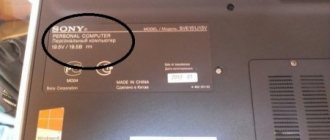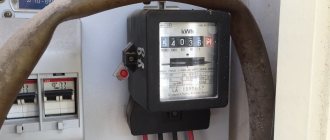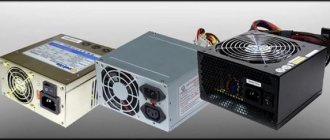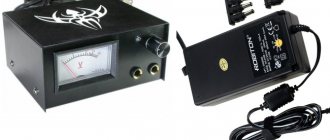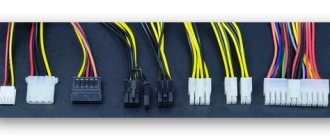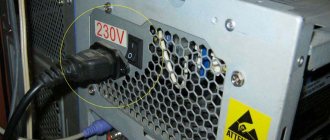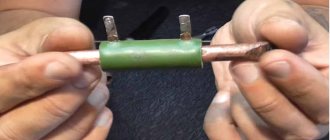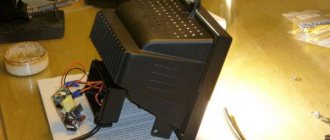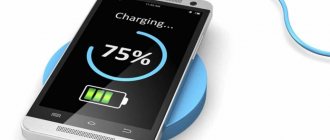Computer power supply gets hot
It is usually quite simple to figure out why the power supply on a computer gets hot.
Since most often this phenomenon occurs for quite standard reasons, of which there is a fairly limited number.
At the same time, eliminating this problem is sometimes possible even without interfering with the PC hardware; software is sufficient.
Signs of overheating
Determining that the computer's power supply is overheating is quite simple. In this case, it is not even necessary to open the case - there are some indirect signs indicating the presence of an increased temperature of the PC component in question.
PC power supply
These include the following:
- sensor readings - the temperature goes beyond the permissible limits;
- the functioning of the operating system slows down;
- the machine restarts itself;
- Coolers spin very quickly for a long time.
What the sensors show
When the PSU heats up excessively, it affects the temperature of all other devices located inside the PC.
You should definitely find out the normal temperature conditions for all parts where the corresponding sensors are present:
- CPU;
- motherboard;
- video card;
- other.
You can find out the sensor readings through the BIOS - many versions display all the necessary values.
bios readings
Special programs are also used for this purpose:
- Speed Fan;
- CPU-Z;
- Core TempReal Temp.
The list is quite extensive.
Works slowly
Another indirect indicator of abnormal operation of the power supply is a strong slowdown of the stationary PC.
Moreover, this affects all tasks that are performed on it:
- working with video files;
- copying and recording to HDD and other media;
- “inhibited” the PC restarts and turns on;
- other tasks that require a large amount of resources.
If the user observes such phenomena, then he should definitely check the sensor readings on his PC. Perhaps the power supply began to release a large amount of heat inside the system unit.
The computer reboots
Sometimes the system may begin to reboot spontaneously. This could be due to viruses, OS problems, or something else. But often this occurs as a result of a strong increase in temperature inside the PC due to overheating of the power supply.
Therefore, if unplanned restarts occur, it is worth using special applications to check the PC hardware.
Fans spin faster
Most modern PCs are equipped with special cooling systems, consisting of radiators and special coolers and fans.
Moreover, the rotation speed of the latter is regulated by the PC independently. Most often, during normal operation, the rotation of moving parts is practically inaudible.
But it happens that the fans make a very loud noise.
fan for power supply
Most often, this happens if sensors receive information about excessively high temperatures.
If in this mode the coolers operate continuously, then this is a serious reason to be wary - perhaps the problem is in a faulty power supply.
In such a situation, it is necessary to perform diagnostics using special programs and conduct a visual inspection of the power supply.
Reasons and solutions
There are many reasons for changing the operating mode of the power supply.
But most often this situation arises because:
- there is a large amount of dust;
- cooling fans are faulty or do not work at all;
- individual electronic components of the power supply have failed;
- there are some design features;
- the radiator does not adhere well to the surface from which heat must be removed;
- the heat-conducting paste has lost its properties (hardened or otherwise);
- work is performed under increased stress;
- The BIOS settings and also the PC operating system are to blame.
Most of these faults can be detected quite simply. Eliminating them is also not difficult. No special knowledge, skills or tools are required for this.
Dustiness
One of the biggest problems with modern computing machines (desktops and laptops) is static electricity. This physical phenomenon causes the appearance of large accumulations of dust and dirt. Its presence can disrupt the normal mode of heat removal from very hot surfaces.
drank a lot in the block
To deal with this problem, you will need:
- crosshead screwdriver;
- vacuum cleaner;
- brush for painting with watercolors.
The cleaning process looks like this:
- It is necessary to open the PC case using a Phillips screwdriver, and then remove all the dust inside it; the power supply is dusty
- disconnect all power supply wire connectors from the motherboard;
- disconnect the power supply, open the cover by unscrewing all the screws present;
- Vacuum the inside of the unit, then brush away any remaining dust using a paint brush.
Fan malfunction
The lion's share of the heat from the heating parts inside the PC is removed by special fans - coolers. They are connected to radiators and directly to heated surfaces through a layer of special heat-conducting paste.
Overheating often occurs when these parts are simply faulty. It is very easy to detect a breakdown - the temperature of the power supply increases greatly, but the cooler does not spin.
There is only one way to resolve this situation - by replacing the broken fan with a new one.
This operation is extremely simple:
- use a Phillips screwdriver to disassemble the housing;
- the power supply is disconnected;
- the block is disassembled;
- disconnecting the power from the cooler; replacing the fan in the power supply
- The bolts securing the fan are unscrewed.
After all the above steps, you need to reassemble everything in reverse order. But at the same time replacing the faulty fan with a new one.
It often happens that the cooler does not spin due to hair or dust getting into the bearings. In this case, you just need to remove the foreign objects and lubricate the device with special silicone grease.
Battery failure
Problems often arise due to the failure of various electronic components located directly on the power supply board. The most common cause of overheating is swollen capacitors. To detect them, simply open the block housing and carefully inspect.
Capacitors are small barrels. If the end part opens, the component has failed.
swollen capacitors
Repair in this case is not as complicated as it might seem. It is necessary to purchase suitable capacitors of appropriate capacity in advance and stock up on a soldering iron.
Replacement is carried out as follows:
- Using a soldering iron, the legs of the capacitor are carefully warmed up;
- when the tin has melted, the component is removed from the board using tongs or tweezers;
- a new capacitor is soldered in.
Computer power supply overheating
The computer power supply (PSU) converts alternating voltage of 220 Volts into direct voltages of 12 Volts, 5 Volts and 3.3 Volts , which are necessary to power the computer components. Malfunctions of the power supply lead to unstable operation of the computer. Overheating of the power supply clearly indicates a problem with its operation.
How to find out the temperature of the computer power supply
The computer power supply does not have temperature sensors , so it will not be possible to measure its temperature using the software method. Overheating can be detected by touch or by a burning smell. If the power supply is equipped with overheating protection, it will turn off when the temperature threshold exceeds 50 degrees .
Eliminating the causes of laptop power supply overheating
The fact that the laptop power supply heats up when charging should not confuse you - this is normal. Another question is if the power supply gets very hot and does not cool down after the battery is fully charged. Let's see why this happens and what to do to prevent your laptop from suffering from overheating.
Reason for heating
The reason that the laptop power supply gets very hot when charging is the underrated power of the adapter. The more powerful the adapter, the less it heats up when charging. But with an increase in power, the size of the power supply will become larger, which negatively affects users’ perception of the laptop.
Therefore, manufacturers select an adapter with the minimum permissible power for the laptop kit. You can charge the laptop, but don’t be surprised that it gets very hot – the adapter has to work at maximum speed.
The block converts alternating current 220V into direct current 15-24V. The conversion is carried out by a transformer, and rectification is carried out by a diode bridge. Depending on the magnitude of the electrical load, both units heat up with varying degrees of intensity during operation.
Typically, maximum heating occurs during the first 20-30 minutes of operation of the laptop with the power supply connected. This is due to the fact that the adapter operates under maximum load, simultaneously charging the battery and maintaining the operation of the computer. As a result, the power supply gets very hot.
But if the adapter remains hot after charging, then this is a reason to pay attention to its condition. Why is this happening? In addition to low power, there may be several other reasons why the power supply gets very hot:
- Too much load on the laptop.
- There is no natural cooling (the power supply is covered with a cloth, lying on the carpet, in direct sunlight).
You should also worry about the condition of the laptop and adapter if, when charging, the power supply gets so hot that you can’t hold it without discomfort. Human skin can withstand temperatures of 60-70 degrees, but if the adapter heats up to 80 degrees, you won’t be able to pick it up.
How to reduce the temperature of the adapter?
Now you know why the laptop power supply gets very hot. It remains to understand how to rid the laptop of this shortcoming. You can try the following methods:
- Place the power supply in an area where it can cool naturally. As noted above, the adapter should not be covered with a blanket or any cloth. It is also contraindicated for him to lie on the carpet and be exposed to direct sunlight.
- Try not to overload the laptop when charging. Wait until the battery charges before launching heavy games or resource-intensive programs.
If neither natural cooling nor temporary abandonment of games reduces the temperature of the power supply, then you will have to buy new equipment with more power.
But to prevent the laptop from burning out, you need to choose the right power supply, taking into account the voltage. Examine the markings on the laptop case.
The charger parameters should be indicated there: for example, 19V-2.4A.
Then look at the current and voltage on the old power supply, which gets very hot. The voltage on it should be the same, but the current strength may be a little higher.
To get rid of overheating, you should buy an adapter with the same voltage (19V) and higher current - for example, 4.7A instead of 2.7A. In this case, the power supply will maintain a low temperature when charging, because the load on the nodes will decrease.
Reasons for heating
Your laptop's charger has a large unit that sits between the plug that goes into the electrical outlet and the adapter that connects to the laptop. This block is actually a transformer. It converts the voltage supplied from the network to 8-16 volts. This is the voltage that most modern computers operate with. This process causes the block to heat up, causing it to become warm to the touch.
Although the charger may become warm during operation, it should not be hot. If you cannot touch the unit or smell a strange odor, the power supply is faulty and must be replaced. There is no point in trying to repair it, since new products are quite cheap. A faulty charger can damage the battery and the laptop itself.
Some more reasons for the power supply to overheat:
- The characteristics of the charger and the laptop battery do not match. For example, exceeding the rated current of the power supply leads to overheating. It's best to replace the battery if this is the case. To verify that the battery is causing the problem, remove it from the laptop and reconnect it to power using the adapter. If the laptop works fine, the problem is with the battery.
- Powerful graphics adapter. If you're gaming on a high-end laptop with the charger connected, the charger will become hotter than usual. The situation gets even worse if you charge the battery while gaming.
Why does my laptop get hot and what can I do about it?
Recently, our site talked about why mobile computers turn off spontaneously. In 80–85% of cases, simple overheating is to blame. Today we will once again briefly list all the possible reasons why a laptop overheats, and we will talk in detail about prevention and methods for solving this problem.
How can you tell if your laptop is overheating?
In the article about laptops turning off spontaneously, we listed symptoms indicating that your iron “pet” is exhausted from fever.
Let us remind you: this is the loud hum of the fan, heating of the case, hot air from the ventilation grille (or, conversely, cold air when there is no effective heat sink), etc.
, but the most objective indicator is data from hardware monitoring programs (Core Temp, HWiNFO, Aida64, Open Hardware Monitor, Real Temp, HWMonitor and others).
Normal processor temperature under moderate load (working in office applications, surfing the web, communicating via instant messenger) is about 40–60 0C with peak rises up to 70–75 0C.
The chipset (bridges) heats up about the same, the video card can heat up to 70-80 0C when watching movies, and under heavy loads (games, rendering 3D images) - almost up to 100 0C. The normal hard drive temperature is 40–50 0C.
All these indicators are approximate; official standards for a specific device can be found on its manufacturer’s website, but accuracy to the nearest degree is not needed to assess overheating.
It happens that monitoring programs determine the temperature incorrectly. For example, they show that it is below room temperature.
If in doubt, reboot the machine and go into BIOS Setup (which key to press for this is written at the bottom of the manufacturer's splash screen).
The necessary information is contained in the PC Health section (other names are Hardware Monitor, Status, etc.). Look at the following parameters:
- CPU Temperature (other names: Processor Temperature, Package Temperature or abbreviated: CPU Temp, Processor Temp, etc.) – processor temperature.
- ICH Temperature (instead of ICH it can be MCH, FCH, THRM) – chipset temperature (the indicator is optional).
If they differ greatly from the program indicators, the latter should not be trusted.
How bad is overheating for a laptop?
Owners of mobile computers, as a rule, are most concerned about the temperature of the processor, but it can withstand intense heat without much harm to itself: each CPU implements a protection technology - clock throttling or, as it is called, throttling. Its essence is to slow down the processor until the temperature drops to a safe level. And if this does not help, the laptop turns off.
Much more than the processor, the video chip is vulnerable.
Modern video cards use the same protection technologies, but the compact cooling system (CO) is not always able to remove such a significant amount of heat that they produce. Long-term operation at abnormal temperature conditions is the main reason for video chip failure.
The hard drive also suffers from high temperatures.
Both the disk itself and the data on it can be rendered unusable by even relatively slight heating - up to 55-60 0C, if it lasts for several hours in a row.
But sudden self-shutdowns of the laptop are especially dangerous for the disk - if the power supply is abruptly stopped, the read-write heads do not have time to park and can damage the magnetic layer.
Do I need to monitor the temperature of laptop devices continuously?
During normal use of the device there is no such need: it is enough to monitor it from time to time. When playing games or other intensive workloads, it is advisable to monitor temperatures, if only to prevent the laptop from shutting down on its own.
For control, you can use any of the above-mentioned utilities, but better - with a sound warning function about overheating, for example, Real Temp.
Real Temp works without installation on your computer (just download and run). It monitors the temperature of the processor cores and video in real time, displays it in the system tray, plus it can write this data to the log.
In the Real Temp window, the screenshot shows the current temperature readings of the CPU cores, the difference with the maximum permissible temperature, which is taken to be 100 0C (Distance TJ Max), as well as the minimum and maximum recorded since the program was launched.
To enable a sound alert when the temperature reaches a maximum, open the settings (Settings button) and in the “Other Settings” section o. For the CPU, set the response threshold to 90 0С, for the GPU (video chip) – 90–95 0С.
From time to time it is advisable to check the heating level of the hard drive. Approaching the upper threshold may indicate incipient problems, and a disk that heats up too much and at the same time slows down is completely unreliable.
There are also a lot of utilities for monitoring the status of your hard drive: HDD Health, HD Tune, CrystalDiskInfo, Hard Disk Sentinel, etc. Choose any one.
The screenshot shows the window of Hard Disk Sentinel Pro, one of the free editions of this program.
The laptop power supply is heating up, what should I do?
It is usually quite simple to figure out why the power supply on a computer gets hot.
Since most often this phenomenon occurs for quite standard reasons, of which there is a fairly limited number.
At the same time, eliminating this problem is sometimes possible even without interfering with the PC hardware; software is sufficient.
Signs of overheating
Determining that the computer's power supply is overheating is quite simple. In this case, it is not even necessary to open the case - there are some indirect signs indicating the presence of an increased temperature of the PC component in question.
PC power supply
These include the following:
- sensor readings - the temperature goes beyond the permissible limits;
- the functioning of the operating system slows down;
- the machine restarts itself;
- Coolers spin very quickly for a long time.
What the sensors show
When the PSU heats up excessively, it affects the temperature of all other devices located inside the PC.
You should definitely find out the normal temperature conditions for all parts where the corresponding sensors are present:
- CPU;
- motherboard;
- video card;
- other.
You can find out the sensor readings through the BIOS - many versions display all the necessary values.
bios readings
Special programs are also used for this purpose:
- Speed Fan;
- CPU-Z;
- Core TempReal Temp.
The list is quite extensive.
Works slowly
Another indirect indicator of abnormal operation of the power supply is a strong slowdown of the stationary PC.
Moreover, this affects all tasks that are performed on it:
- working with video files;
- copying and recording to HDD and other media;
- “inhibited” the PC restarts and turns on;
- other tasks that require a large amount of resources.
If the user observes such phenomena, then he should definitely check the sensor readings on his PC. Perhaps the power supply began to release a large amount of heat inside the system unit.
The computer reboots
Sometimes the system may begin to reboot spontaneously. This could be due to viruses, OS problems, or something else. But often this occurs as a result of a strong increase in temperature inside the PC due to overheating of the power supply.
Why does my laptop get hot and what should I do?
Any modern personal computer, be it a desktop PC or a laptop, heats up during operation. The central processor and (if present) the graphics processor are subject to the greatest heating. In most cases, this is due to low efficiency of the ventilation system, but there are other reasons.
Why does my laptop's power supply get hot?
It is usually quite simple to figure out why the power supply on a computer gets hot.
Since most often this phenomenon occurs for quite standard reasons, of which there is a fairly limited number.
At the same time, eliminating this problem is sometimes possible even without interfering with the PC hardware; software is sufficient.
Signs of overheating
Determining that the computer's power supply is overheating is quite simple. In this case, it is not even necessary to open the case - there are some indirect signs indicating the presence of an increased temperature of the PC component in question.
PC power supply
These include the following:
- sensor readings - the temperature goes beyond the permissible limits;
- the functioning of the operating system slows down;
- the machine restarts itself;
- Coolers spin very quickly for a long time.
What the sensors show
When the PSU heats up excessively, it affects the temperature of all other devices located inside the PC.
You should definitely find out the normal temperature conditions for all parts where the corresponding sensors are present:
- CPU;
- motherboard;
- video card;
- other.
You can find out the sensor readings through the BIOS - many versions display all the necessary values.
bios readings
Special programs are also used for this purpose:
- Speed Fan;
- CPU-Z;
- Core TempReal Temp.
The list is quite extensive.
Works slowly
Another indirect indicator of abnormal operation of the power supply is a strong slowdown of the stationary PC.
Moreover, this affects all tasks that are performed on it:
- working with video files;
- copying and recording to HDD and other media;
- “inhibited” the PC restarts and turns on;
- other tasks that require a large amount of resources.
If the user observes such phenomena, then he should definitely check the sensor readings on his PC. Perhaps the power supply began to release a large amount of heat inside the system unit.
The computer reboots
Sometimes the system may begin to reboot spontaneously. This could be due to viruses, OS problems, or something else. But often this occurs as a result of a strong increase in temperature inside the PC due to overheating of the power supply.
Therefore, if unplanned restarts occur, it is worth using special applications to check the PC hardware.
Fans spin faster
Most modern PCs are equipped with special cooling systems, consisting of radiators and special coolers and fans.
Moreover, the rotation speed of the latter is regulated by the PC independently. Most often, during normal operation, the rotation of moving parts is practically inaudible.
But it happens that the fans make a very loud noise.
fan for power supply
Most often, this happens if sensors receive information about excessively high temperatures.
If in this mode the coolers operate continuously, then this is a serious reason to be wary - perhaps the problem is in a faulty power supply.
In such a situation, it is necessary to perform diagnostics using special programs and conduct a visual inspection of the power supply.
Reasons and solutions
There are many reasons for changing the operating mode of the power supply.
But most often this situation arises because:
- there is a large amount of dust;
- cooling fans are faulty or do not work at all;
- individual electronic components of the power supply have failed;
- there are some design features;
- the radiator does not adhere well to the surface from which heat must be removed;
- the heat-conducting paste has lost its properties (hardened or otherwise);
- work is performed under increased stress;
- The BIOS settings and also the PC operating system are to blame.
Most of these faults can be detected quite simply. Eliminating them is also not difficult. No special knowledge, skills or tools are required for this.
Dustiness
One of the biggest problems with modern computing machines (desktops and laptops) is static electricity. This physical phenomenon causes the appearance of large accumulations of dust and dirt. Its presence can disrupt the normal mode of heat removal from very hot surfaces.
drank a lot in the block
To deal with this problem, you will need:
- crosshead screwdriver;
- vacuum cleaner;
- brush for painting with watercolors.
The cleaning process looks like this:
- It is necessary to open the PC case using a Phillips screwdriver, and then remove all the dust inside it; the power supply is dusty
- disconnect all power supply wire connectors from the motherboard;
- disconnect the power supply, open the cover by unscrewing all the screws present;
- Vacuum the inside of the unit, then brush away any remaining dust using a paint brush.
